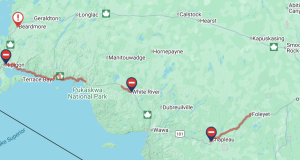Manitou Gold Inc. is pleased to provide details on several newly identified gold targets, as well as the discovery of a new nickel-bearing ultramafic complex on its Goudreau project in northern Ontario with the same host mineralization as Canada Nickel’s Crawford deposit. Recently completed diamond drilling continues to emphasize the gold discovery potential along the Baltimore deformation zone (the “BDZ”), which represents the fault offset extension of the GLDZ, which hosts the Island Gold and Magino mines, as well as several other past producing gold mines.
Drill Program Highlights:
- 0.25% Ni over 48 m in strongly serpentinized ultramafic rocks encountered in hole MTU-21-14. Nickel mineralization started at the bedrock surface. Nickel grade and geological setting similar and analogous to Dumont and Crawford deposits.
- Several ultramafic intrusive bodies prospective for nickel have been identified on Manitou property.
- Several gold targets identified outside the ~2 km strike length of the Baltimore deformation corridor which was tested during the winter drilling program
Manitou Gold is pleased to provide details on several new gold targets, as well as the discovery of a new nickel bearing ultramafic complex on its Goudreau project in northern Ontario. Recently completed diamond drilling continues to emphasize the gold discovery potential along the BDZ, which represents the fault offset extension of the GLDZ, which hosts the Island gold and Magino mines, as well as serval other past producing gold mines.
Winter drilling focused along a short, two kilometer long segment of the largely untested western 10 kilometres of the BDZ. Although gold grades encountered were sub-economic, drilling has confirmed the presence of important geological structures and alteration that highlight the host rocks’ prospectivity for gold mineralization. Drilling intersected a complex east-northeast striking greenstone and metasedimentary sequence intruded by sill-like intrusive bodies that include feldspar porphyry, a variety of mafic to felsic dikes, and several large ultramafic intrusions. Intermediate to felsic volcanics predominate the upper portion of the sequence, with feldspar porphyries and ultramafics being the dominant intrusives. The greenstone stratigraphy is cross-cut by several east-southeast striking oblique-slip faults. Individual shear zones within the corridor, comprising the larger Baltimore deformation corridor, occur proximal to the margins of three large granitoid bodies and are characterized by locally intense sericitization and carbonate alteration, both of which are important alteration styles found in host rocks mined at the Island Gold mine.
Several new gold targets have been identified along the central-eastern portion of the BDZ grid. These targets are summarized below:
G1 – This target is defined by elevated Au-in-soil values over numerous sites. Chalcophile elements including As, Sb, Bi, In and Hg-in soils are moderately elevated; Cs and Rb are potentially indicative of alteration. The soil anomalies appear to be spatially related to several interpreted low-angle structural intersections.
G2 – This target is a magnetized anomaly at the intersection of a dike and metasedimentary rocks. Au, Zn and Cd in soil values around this anomaly are notably elevated.
G3 – Three prominent structural intersections are present within this target area. Au in soils and chalcophile elements including As, Sb, BI, In, and Hg are notably elevated around these targets.
G4 – Consists of an approximately one kilometre long Au in-soil anomaly, which is broadly coincident with an interpreted 110°striking interpreted tertiary shear zone.
G5 – Two IP chargeability anomalies within felsic volcanic package. Chargeability anomalies are interpreted to be caused by sulphide mineralization. The eastern anomaly occurs proximal to the structural intersection of a 120° striking shear zone and 150° cross-fault.
The BDZ is a long-lived and deep-seated structure and is interpreted as being responsible for the emplacement of the large volumes of mafic-ultramafic rocks along the deformation corridor, including the newly identified ultramafic intrusion, where hole MTU-22-14 intersected a 50 m wide interval of highly serpentinized ultramafic rocks, analogous to the Crawford and Dumont nickel deposits, grading 0.25% Ni between 29.0 to 77 metre after reaching bedrock. Hole MTU-22-14 was collared in mineralization near the southern margin of the ultramafic intrusion and therefore did not intersect the full width of the mineralized zone.
Ultramafic intrusions along the Baltimore deformation zone occur over a minimum strike length of 3.5 kilometres, with individual bodies up to 1.5 kilometres long and 200 metres wide. Altered and potentially mineralized ultramafic rocks display distinct moderate to high magnetic character as a result of the serpentinization of an olivine rich ultramafic protolith where olivine reacts with water to form serpentine group minerals and magnetite, as well as high purity nickel sulfides and nickel alloys. The IP survey conducted in 2021 has outlined several chargeability anomalies that that are coincident with the magnetic-high responses and known ultramafic rocks. Aside from hole MTU-22-14, these bodies have never been drill tested.
The Company will be implementing a follow-up ground exploration program designed to further advance both gold and base metal targets identified to date. The program will include a combination of soil geochemistry, prospecting and potentially mechanized stripping in advance of drill testing these targets.
- Letter to Doug Ford – Another Devastating Tragedy on Northern Ontario Highway - December 23, 2025
- NAPS lay charges in historic child abuse investigation - December 23, 2025
- Federal Offender arrested in Timmins - December 23, 2025
 Wawa-news.com You can't hear the 'big picture'!
Wawa-news.com You can't hear the 'big picture'!

